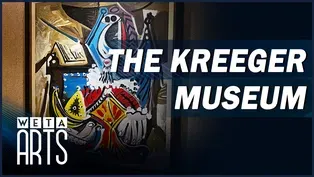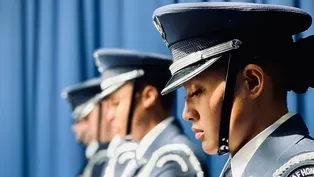
Go Behind the Scenes with the US Air Force Honor Guard Drill Team
Clip: Season 12 Episode 3 | 9m 51sVideo has Closed Captions
Go behind the scenes with the U.S. Air Force Honor Guard Drill Team.
Experience the unmatched skill and discipline of the United States Air Force Honor Guard Drill Team! Join WETA Arts host Felicia Curry as she takes you behind the scenes at Joint Base Anacostia-Bolling, where these airmen practice breathtakingly synchronized drills and ceremonial routines. With rigorous training and a commitment to “Honor with Dignity,” the drill team performs around the world.
Problems with Closed Captions? Closed Captioning Feedback
Problems with Closed Captions? Closed Captioning Feedback
WETA Arts is a local public television program presented by WETA

Go Behind the Scenes with the US Air Force Honor Guard Drill Team
Clip: Season 12 Episode 3 | 9m 51sVideo has Closed Captions
Experience the unmatched skill and discipline of the United States Air Force Honor Guard Drill Team! Join WETA Arts host Felicia Curry as she takes you behind the scenes at Joint Base Anacostia-Bolling, where these airmen practice breathtakingly synchronized drills and ceremonial routines. With rigorous training and a commitment to “Honor with Dignity,” the drill team performs around the world.
Problems with Closed Captions? Closed Captioning Feedback
How to Watch WETA Arts
WETA Arts is available to stream on pbs.org and the free PBS App, available on iPhone, Apple TV, Android TV, Android smartphones, Amazon Fire TV, Amazon Fire Tablet, Roku, Samsung Smart TV, and Vizio.
Providing Support for PBS.org
Learn Moreabout PBS online sponsorship♪ Felicia Curry: Off Interstate 295 in Southwest DC at Joint Base Anacostia-Bolling, members of the United States Air Force Honor Guard aim for perfect synchronicity.
[Officer shouts indistinctly] Man: All the service branches have honor guards or ceremonial units, and our primary mission is to provide funeral honors for military members in Arlington National Cemeteries.
So if you think about the people that carry the caskets, that's the pallbearer team.
The 21-gun salute everyone knows about, and the color teams that march, those are the different elements of a funeral.
[Officer says command] Curry: But within the Honor Guard, there is an elite unit that takes performance to another level.
It's called the Drill Team, and its leader is Master Sergeant Ken Barrows.
Ken Barrows: So the whole Honor Guard's mission is "To Honor With Dignity."
We go out and do funerals and ceremonies, but the Drill Team's mission specifically is to recruit, retain, inspire.
So we will do other high-visibility missions with Air Force leadership and even United States leadership, like the president and secretary of defense.
We go out to international military band performances.
We go out to air shows to see if we can give back to the community, as well as see if we can bring in any potential recruits.
[Spectators cheer] The original purpose of drilling is to win the battle.
Curry: Military drilling in the United States dates back to the Revolutionary War.
Rodney McKinley: The most disciplined force, the best organized one that can respond to commands quickly, they're usually going to be able to win.
Anytime you get a group of airmen together... [Officer says command] and you have a narrow focus on precision drill, naturally, these members are going to want to elevate their skills and go beyond just the basic weapons, tactical purpose, and are designed a little more to entertain, or to challenge the member.
It's not easy to do what they do, that 11-pound weapon.
It's not easy to choreograph something like that.
We're one of the only services where the weapon leaves their hands constantly and one of the only services where we redo our routine every year.
Officer: Stand-easy.
You know what they say: Amateurs practice till they get it right; professionals practice until they can't get it wrong.
So we're going to do another one.
Move.
Peter Mask: Perfection is our goal, but excellence is always our standard.
[Officer says command] Curry: Once you're in the Honor Guard, you can apply to be on the Drill Team.
Barrows: I'm looking for a good airman first.
A good airman follows our core values-- integrity first, service before self, and excellence in all we do.
A good airman will come in here, they'll put the work in, and they're going to be excellent.
Curry: The Drill Team finds recruits in many ways.
There is a sergeant-- his name is Sergeant Day-- and he was posting about the Drill Team on TikTok.
And I just thought, That is the coolest thing I've ever seen.
Looked so fun, so I wanted to be a part of that.
Curry: While women have been in the Air Force since it was created in 1948, they only became eligible to join the Honor Guard in 1971.
McKinley: In 1976, women started performing as pallbearers, as color guard, as firing party.
And then by the early eighties, Senior Airman Lori Meyers, she became the first female on the Air Force Honor Guard Drill Team, and she paved the way for a number of women to serve on the Drill Team.
Kai Norwood: Being the ninth female on the Drill Team since 1948 has truly been an honor.
So when I first applied for the Honor Guard Drill Team, I didn't make it because I just was not strong enough.
Norwood: Unfortunately, we're not as strong as the men, genetically speaking, so it's very difficult, but it's all mental.
I would come in early to work to try to train with one of the trainers, stay after work, did everything that I could, and then the second time around, thankfully, I made it.
We did change the requirements to be more inclusive.
So the height requirement we used to have was 5'10", got changed to 5'6".
And it doesn't matter what gender.
And when they do the routine, the maneuvers aren't modified because of gender.
They just have to learn how to manipulate the weapon.
♪ Curry: Those admitted to the team must first perfect the drills.
They will spend another 4-6 months typically learning how to actually be performance ready.
Airman Buford's been on Drill Team for about three months now.
She's not quite performance ready yet.
Buford: I started off strong, then I got injured.
And it was kind of a struggle after that, but I definitely kept trying my hardest.
I did not want to give up because I really wanted to join.
Norwood: She's amazing, very good driller, has the right mind-set.
She's smaller than me, so you can imagine [Chuckles] how that goes.
Zephrendae Buford: I don't have a very big wingspan, so it's definitely a process of making sure that you're still doing things properly but also not looking crazy.
[Laughs] Curry: And timing is paramount if you're going to create a gauntlet of spinning bayoneted rifles.
Barrows: The first time I ever tried it, I got hit.
It's learning the right steps and the right cadence.
I put a lot of trust in my trainers, telling me, "Hey, this guy's ready to go."
When they tell me that, it's like, "OK, I know I can walk through there and not get hit."
Curry: Today's performance is at National Harbor.
[Officer saying commands] Barrows: The event is called the Drill at Dusk.
This one's considered a halftime drill.
It's about seven minutes long.
Atten-hut.
Announcer: And now leading the charge, Master Sergeant Kenneth Barrows of your United States Air Force Honor Guard Drill Team!
[Cheering] As in every Air Force mission, the Drill Team executes each movement with flawless timing and exacting precision.
♪ McKinley: The philosophies that we follow haven't changed from 1948.
There's still the desire to take everything a step further-- excellence in all we do, to serve others, to honor with dignity.
All those things remain the same.
♪ Announcer: In order to accelerate change, the Air Force continues to evolve into a stronger, more efficient fighting force.
The Drill Team is no exception.
Although our routine is frequently revised and improved upon, one tradition remains the same-- the use of the line formation.
Watch the domino effect created by the quick reflexes of each team member, then make some noise and show some love.
The louder you cheer, the harder they will perform.
[Cheering and applause] ♪ [Cheering] I would say it's art.
That precision, that discipline, it really does reach people.
♪ [Cheering and applause] ♪ Announcer: Representing every member past and present of the United States Air Force, your United States Air Force Honor Guard Drill Team!
[Cheering and applause] Man: So it's pretty impressive.
I'm not gonna lie.
I liked the performance.
Just the way that they maneuvered those weapons.
I was like, "What the...?"
I've never seen that in my life.
Officer: Team, fall out... Buford: Watching these inspires me to work harder and be better so that I can be out here doing it with them.
Barrows: I thought it was a really good performance.
I'm really proud of them.
There was a couple nerve-wracking parts in there for myself, but it worked out really well.
Norwood: I wanted to be able to show that you can do this whether you're a man, whether you're a woman, whether you're short, or whether you're tall.
I wanted to be able to show all the little girls out there, or even the boys out there, that anybody can do it and anyone can be a part of that change.
You just have to have the right mind-set.
Curry: The Drill Team performs up to 150 times a year around the world.
Follow them on Instagram @USAFDrillTeam.
Experience the Ocean's Twilight Zone at ARTECHOUSE
Video has Closed Captions
A groundbreaking digital exhibition brings deep ocean life to Washington, D.C. (9m 25s)
The Kreeger Museum Offers a Unique Art Experience in Washington DC
Video has Closed Captions
Discover why the Kreeger Museum offers a unique art experience in Washington, D.C. (7m 7s)
Preview: WETA Arts November 2024
The Air Force Honor Guard Drill Team, ARTECHOUSE, and the Kreeger Museum (30s)
Providing Support for PBS.org
Learn Moreabout PBS online sponsorshipSupport for PBS provided by:
WETA Arts is a local public television program presented by WETA














